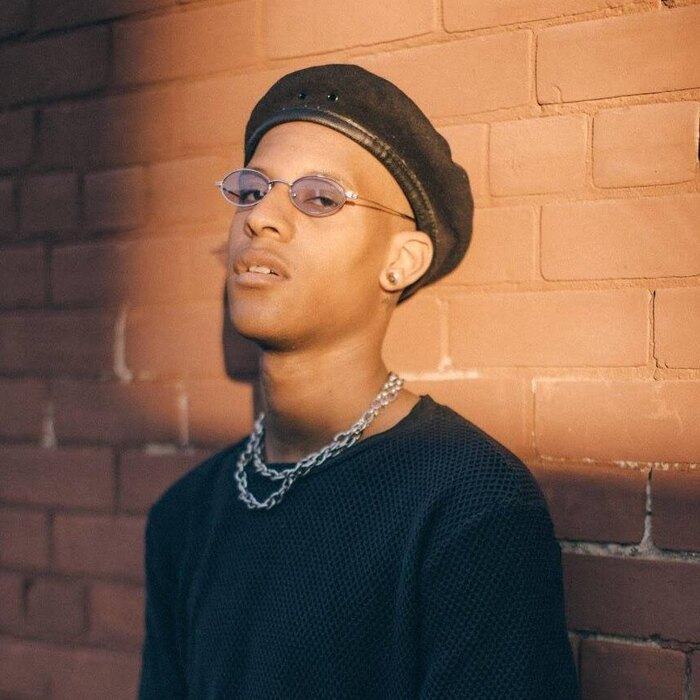Purveyor of: The precarious space between electronic and hip-hop music that is full of bold melodies, strong rap, and iconic beats.
File next to: Cadence Weapon, Internet Daughter
Playing: WL18 Beyond the Core Panel, Thursday, Feb. 15 @ The Gladstone Hotel Ballroom (7pm, FREE).
Just John may be young, but he’s already a Toronto staple in the music and art scenes, garnering attention from the likes of Noisey, Complex, and the Art Gallery of Ontario. Just John’s most recent artistic project, his EP Black Beret, is a hard-hitting trip into his mind, as well as his world. Wavelength’s Emily Scherzinger delves into the practices behind his music, the necessity of DIY spaces, and more.
I love how, on your Facebook page, your music is described as “audible illustrations.” How does your work as an art curator inform your musical practice?
I describe it as audible illustrations because I’m painting stories sonically and exhibiting my truth. I make the music and people can draw the parallels. People are supposed to be multi-faceted. I mean, look at Pharrell Williams, Swizz Beatz, or Tyler, The Creator. I don’t categorize other parts of my personality as subordinate. Instead, I look at them as another avenue for expression. Curation, to me, is a matter of choices and experiences. I like how it’s able to transition me into contemporary art worlds while I can still keep a pulse on my community.
I read about the “5 characters you’ll meet” in the video for “Facts” in your interview with Good Juice Box. These characters are represented through the five different outfits you wear throughout the video. Can you tell me about those personas, as well as the persona you bring to the stage, either through fashion, crowd interaction, or other means?
On stage you’ll get a lot of energy, and my main initiative is to push people to just be themselves whether through fashion or my experiences. In the recently released “FACTS” music video, the personas aim to represent certain personality traits of mine, at different points in my life. It’s about my journey of rebirth.
Toronto seems to be in the midst of a big contradiction: we tout our great art and music scenes, all the while closing down the DIY spaces that produce and house said scenes, as evidenced in the gallery you co-own, Blank Canvas. What can you say about this paradox? There obviously isn’t an easy solution, but do you see some potential in restoring or founding more DIY spaces in Toronto’s future?
I mentioned in Noisey that, if Toronto is the most diverse city in the world, then it needs to put more money into building the infrastructure. Artists are pushing the culture and now the world’s watching. This should be the moment to help lay the foundation so that there’s longevity in shifting the cultural landscape for the better. But the whole point of DIY is to do it yourself. These spaces arise from necessity due to lack of representation of a specific cultural group. They’re cultural hotspots and act as the Mecca for artists to meet, share dialogue and collaborate. Artists are bringing up the value in these areas and setting trends for condo developers, but get nothing in return so I’m drawing attention to those things. DIY spaces will continue to pop up, and they should — we just have to keep making them ourselves. If we get money from the city then that’s always a plus and a move in the right direction.
Black Beret deals with a lot of issues that affect racialized youth in Toronto, such as police brutality, gentrification, safe spaces, and more — all in four songs! Can you speak about your experience making this EP, especially when dealing with such big and tough topics?
Black Beret is an exact timestamp of where I was as a 23 year-old black youth navigating inner city Toronto. It was a maturing year for me. Everything I write happens to me or the people around me, so It was a direct draw of the influences that were shaping me at the time: I was at Blank Canvas everyday, reading about all these black kids being shot in the streets, experiencing police violence myself, being pushed out of art spaces, Trump had just been elected. Damn, a lot was going on, and it felt important for me to archive this moment of self actualization, adversity, resilience, and growth.
Finally, Black Beret is freshly released off of the Bedroomer label, but it’s never too early to start thinking about new projects, right? What goals do you have for the future? How do you see your work moving, changing, and growing?
I have more music and music videos coming up and I’m just constantly challenging myself as an artist and growing the vision. Keep plugged.
— Interview by Emily Scherzinger

